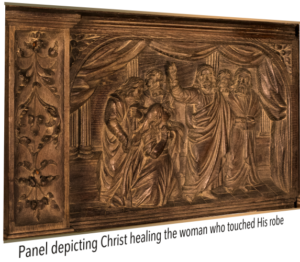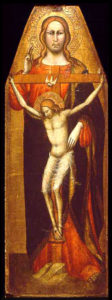Madonna and Child with Saints
Pietro Alemanno
Below the image, click play to listen.
This depiction of St. John the Evangelist by the Master of Cueza provides an intriguing look at various accoutrements used by medieval scribes.
In this polyptych (or multi-paneled altarpiece) Gerini not only highlights the Madonna and Christ Child, but also explores the life of Mary Magdalene in his predella.
This is the only signed picture by this early Italian master. It also includes 55 faces!
Oak
Flemish, 16th century
Churches and cathedrals throughout time have something architecturally in common: a location for the choir. Where the choir is placed differs in the various places of worship, yet the choir accentuates the central focus of the church: the altar. In many early European monasteries and later collegiate churches, the choir was positioned along the chancel which separates the nave (where the laity would sit) from the altar. The chancel is lined with rows of seating for the choir members. Every detail within Medieval and Renaissance places of worship were handcrafted, including the choir’s seating or choir stalls.
Choir stalls consist of carved, individual seats divided by armrests; these seats are attached to a long, carved dorsal panel (a short or high backrest board) and sometimes a canopy. M&G’s pair of sturdy oak Choir Stalls date to the 16th century and were designed by Gothic Flemish artist Jan Terwen Aertsz.
Little is known about Jan Terwen Aertzs. who lived a long life of 78 years. Born in 1511 and later educated at the Dordrecht School, Jan was considered a master woodcarver in Dort, also known as Dordrecht. While the exact church in the Netherlands from which M&G’s Choir Stalls originate remains a mystery, the location of Jan’s greatest work is on view in the Grote Kerk in Dordrecht. The church’s choir stalls, made between 1538-1542, demonstrate Jan’s skill and eye for detail, and are pristine examples of Flemish woodworking in the 16th century.
 M&G’s Choir Stalls provide two sets of four seats each and are covered in finely detailed carvings. For example, the fins under the armrest are devised to look like eagles with every feather individually carved into the hard oak. The dorsal and end panels of the stalls contain images from various Biblical stories, including King Solomon displaying his God-given wisdom with the two mothers, and the believing woman healed by just a touch of Christ’s robe. Every minute design is accounted for—from the patterned hem of a character’s tunic, and the hair on Jesus’ head and beard, to the scenes’ distant mountains in the background, and the patterns in the tile underfoot. Surrounding these narratives are decorated spindles and more reliefs consisting of fruit and flowers flanked by winged, mythological creatures.
M&G’s Choir Stalls provide two sets of four seats each and are covered in finely detailed carvings. For example, the fins under the armrest are devised to look like eagles with every feather individually carved into the hard oak. The dorsal and end panels of the stalls contain images from various Biblical stories, including King Solomon displaying his God-given wisdom with the two mothers, and the believing woman healed by just a touch of Christ’s robe. Every minute design is accounted for—from the patterned hem of a character’s tunic, and the hair on Jesus’ head and beard, to the scenes’ distant mountains in the background, and the patterns in the tile underfoot. Surrounding these narratives are decorated spindles and more reliefs consisting of fruit and flowers flanked by winged, mythological creatures.
 One of the most fascinating details of the Choir Stalls are the misericords. Misericords (from the Latin word for pity and heart, literally pity of the heart or compassion of the heart) are molded brackets on the underside of a seat. Choirs or monks would stand for hours singing and participating in the worship ceremony; to provide them with a modicum of comfort and stability, these misericords or “mercy seats” were added. When the choir members would stand to sing, they could lift the seat up and surreptitiously rest against this small structure while still appearing to be standing.
One of the most fascinating details of the Choir Stalls are the misericords. Misericords (from the Latin word for pity and heart, literally pity of the heart or compassion of the heart) are molded brackets on the underside of a seat. Choirs or monks would stand for hours singing and participating in the worship ceremony; to provide them with a modicum of comfort and stability, these misericords or “mercy seats” were added. When the choir members would stand to sing, they could lift the seat up and surreptitiously rest against this small structure while still appearing to be standing.
The ownership history, or provenance, of these beautiful seats is long, mysterious, and fascinating. The choir stalls survived the iconoclasm that followed the Protestant Reformation sweeping through the Netherlands as staunch Catholic Philip II of Spain fought to retain Flanders, where they remained undamaged until the early 20th century. As America entered the Gilded Age with its booming economy, many American business and factory owners became millionaires; they wished to display their newly-earned wealth and position by designing grand homes decorated in the Old-World style. Men like architect Stanford White were sent to Europe to purchase whole rooms of traditional Medieval or Renaissance décor and ship the furnishings back to America. White chose the Choir Stalls to adorn Hearst Castle built by William Randolph Hearst, the newspaper magnate. The choir stalls decorated Hearst’s home until his bankruptcy during the Great Depression. In 1941, Hammer Galleries acquired the choir stalls at auction. A later owner gifted the Choir Stalls to the Collection in 1968, where they found a home among objects and paintings of the same age. While they are not being used for their original purpose, the Choir Stalls allow M&G’s guests a glimpse into 16th-century cathedrals.
Ashley Ellis, M&G History Intern
Published in 2019
Tempera on panel
Florentine, active 1392–1412

Lorenzo di Niccolò worked in Florence around the turn of the fifteenth century—one of the most significant centuries in history known as the Renaissance. Painting during this period continued in the tradition of Giotto (begun a century earlier), and Lorenzo’s own style was not much different from that tradition along with other contemporary artists. While paintings of the Trinity were common imagery within altarpieces of the time, Niccolò’s depiction is unique—painted in a way never done before. All known earlier representations of the Trinity in this configuration (known as “The Mercy Seat”) are depicted with God the Father sitting behind the crucified Christ; whereas, here, God the Father is shown standing.
Perhaps today this seems like an insignificant modification, but in the fourteenth century iconography was more codified; deviations articulated meaning, tradition, and Church dogma—all issues firmly upheld and monitored by Church officials. Interestingly, Trinity subjects with God the Father in a standing position were rare until the same concept appeared about 20 years later in one of the most famous paintings in history, Masaccio’s fresco of the Holy Trinity at Santa Maria Novella, Florence.
Another nuance of Niccolò’s imagery is that God the Father is also shown as a young man—the same likeness used for Christ. This approach heightens the physical and spiritual connection between the Father and Son, who are mysteriously distinct persons in a unified Trinity. However, the depiction of a youthful Heavenly Father was later forbidden by papal edict revealing that the iconography shown in this painting was short lived in art history.
An intriguing facet of this panel is that the entire back side of the panel is painted (with the exception of areas of wear and damage expected for an artwork over 600 years old). A full, decorative reverse side of a painting is somewhat common to early Italian panel paintings and suggests that people were intended to view the reverse. Sometimes entire narratives or portraits are found on the back of paintings; others have painted inscriptions or symbols for organizations such as confraternities. However, the pattern and application here supply a completely abstract, decorative function. In fact, the effect was intended to mimic the type of decorative marble inlaid patterns commonly incorporated into many existing Florentine churches, including the Duomo, Santa Maria Novella, and Santa Croce.
Preliminary research has revealed an almost identical pattern for what we see on this panel on a wall fresco border painted by Agnolo Gaddi in 1380 at Santa Croce. This pattern could be a clue to its inclusion in that same church to match the existing faux stonework existing on the walls. The pattern is distinct and would have the same markings as some or all of the other panels associated with the altarpiece from which this panel came. Such unique features can aid in attribution and dating, if related panels have firm documentation.
John M. Nolan, Curator
Published in 2014